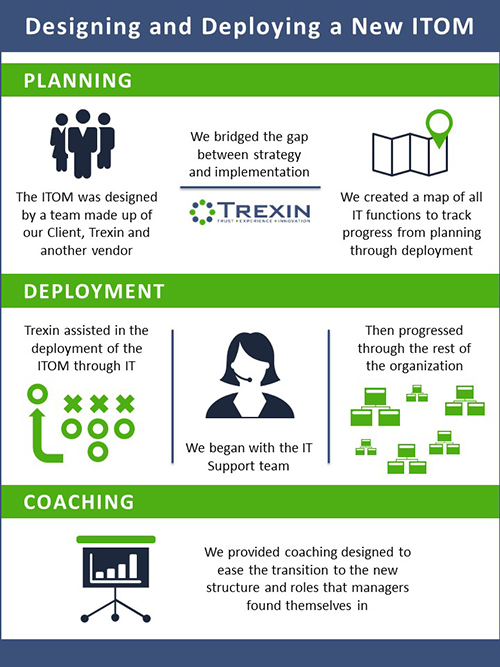Case Study February 16, 2016
Building an IT Operating Model for a Large Health Insurer
Trexin helped one of the largest health insurance providers in the country develop and implement an IT Operating Model that improves alignment between business and IT teams, empowers employees, and improves the quality and efficiency of projects and deliverables
Business Driver
Our Client, one of the largest customer-owned health insurance companies in the country, needed to improve the efficiency and the quality of output generated by their IT organization.
Their lines of business (LOB) are incredibly diverse, including government, group, and retail consumer healthcare plans. These LOBs exist at different levels of maturity and have widely varying business and government regulatory requirements. Because of this, the enterprise must be able to rely on the capabilities and flexibility of their IT infrastructure to support their strategic objectives, and our Client felt that significant improvement in this area was required.
Our Client recognized the need for an IT Operating Model (ITOM) that would create stronger alignment between their business and IT teams and improve the quality and efficiency of projects and deliverables while providing increased engagement and growth opportunities for staff. The CIO asked Trexin to help develop and implement a new, human-oriented ITOM designed to meet these needs.
Approach
Trexin collaborated with our Client’s IT leadership and a third-party vendor to architect an ITOM and its supporting processes, roles, and descriptions. The final design was customized to achieve our Client’s goals of increasing IT effectiveness, business alignment, delivery excellence, and speed to market. It also included sweeping changes in the staffing model with a focus on coaching and generating growth opportunities for employees.
Over the course of this engagement, Trexin served as the bridge between the strategy and implementation. In this role, we worked closely with our Client and the third-party vendor to develop the detailed plan for deployment.
Part of this strategy was managing the division of labor and establishing efficient communication between our teams. In order to manage a project of this size and complexity, we created a “placemat” – a detailed map that represents all IT functions and their current status. Using this placemat allowed us to manage each function’s status as they progressed from the strategizing phase through to implementation.
Deployment began with IT support, the area most in need of the new support structure, and then methodically progressed through each subsequent organizational area, eventually reaching beyond IT and covering the entire enterprise.

Results
Our Client now has a new ITOM in place that gives them the improved processes, methods, and models that can support the demands of their LOBs. They are now in a position to achieve their goals of stronger alignment between business and IT teams and improved output quality and efficiency.
The changes made to the staffing models and training practices have also begun the process of developing an empowered workforce. And to further our Client’s goal of making this initiative a human-oriented paradigm shift, Trexin was retained to provide coaching to key managers as they progress through the transition into the new responsibilities and roles that are part of the new ITOM structure.

